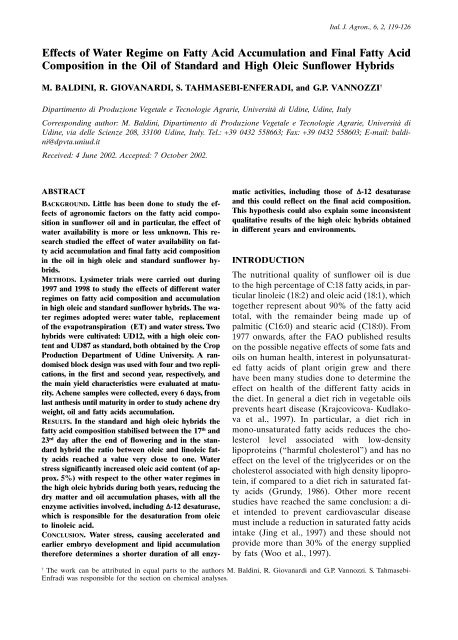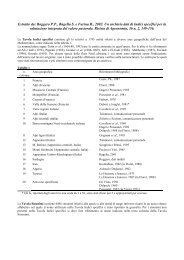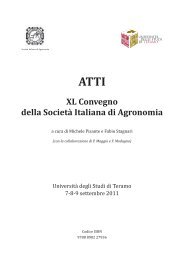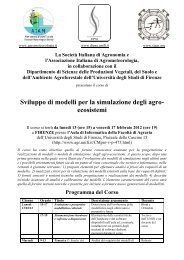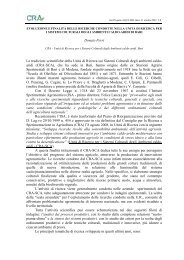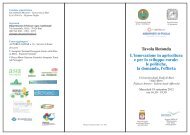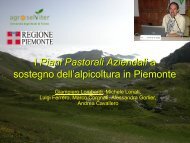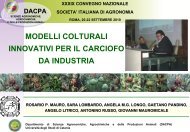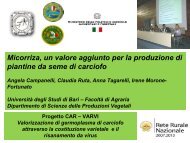Create successful ePaper yourself
Turn your PDF publications into a flip-book with our unique Google optimized e-Paper software.
Ital. J. Agron., 6, 2, 119-126<br />
Effects of Water Regime on Fatty Acid Accumulation and Final Fatty Acid<br />
Composition in the Oil of Standard and High Oleic Sunflower Hybrids<br />
M. BALDINI, R. GIOVANARDI, S. TAHMASEBI-ENFERADI, and G.P. VANNOZZI †<br />
Dipartimento di Produzione Vegetale e Tecnologie Agrarie, Università di Udine, Udine, Italy<br />
Corresponding author: M. Baldini, Dipartimento di Produzione Vegetale e Tecnologie Agrarie, Università di<br />
Udine, via delle Scienze 208, 33100 Udine, Italy. Tel.: +39 0432 558663; Fax: +39 0432 558603; E-mail: baldini@dpvta.uniud.it<br />
Received: 4 June 2002. Accepted: 7 October 2002.<br />
ABSTRACT<br />
BACKGROUND. Little has been done to study the effects<br />
of agronomic factors on the fatty acid composition<br />
in sunflower oil and in particular, the effect of<br />
water availability is more or less unknown. This research<br />
studied the effect of water availability on fatty<br />
acid accumulation and final fatty acid composition<br />
in the oil in high oleic and standard sunflower hybrids.<br />
METHODS. Lysimeter trials were carried out during<br />
1997 and 1998 to study the effects of different water<br />
regimes on fatty acid composition and accumulation<br />
in high oleic and standard sunflower hybrids. The water<br />
regimes adopted were: water table, replacement<br />
of the evapotranspiration (ET) and water stress. Two<br />
hybrids were cultivated: UD12, with a high oleic content<br />
and UD87 as standard, both obtained by the Crop<br />
Production Department of Udine University. A randomised<br />
block design was used with four and two replications,<br />
in the first and second year, respectively, and<br />
the main yield characteristics were evaluated at maturity.<br />
Achene samples were collected, every 6 days, from<br />
last anthesis until maturity in order to study achene dry<br />
weight, oil and fatty acids accumulation.<br />
RESULTS. In the standard and high oleic hybrids the<br />
fatty acid composition stabilised between the 17th and<br />
23rd day after the end of flowering and in the standard<br />
hybrid the ratio between oleic and linoleic fatty<br />
acids reached a value very close to one. Water<br />
stress significantly increased oleic acid content (of approx.<br />
5%) with respect to the other water regimes in<br />
the high oleic hybrids during both years, reducing the<br />
dry matter and oil accumulation phases, with all the<br />
enzyme activities in<strong>vol</strong>ved, including ∆-12 desaturase,<br />
which is responsible for the desaturation from oleic<br />
to linoleic acid.<br />
CONCLUSION. Water stress, causing accelerated and<br />
earlier embryo development and lipid accumulation<br />
therefore determines a shorter duration of all enzy-<br />
matic activities, including those of ∆-12 desaturase<br />
and this could reflect on the final acid composition.<br />
This hypothesis could also explain some inconsistent<br />
qualitative results of the high oleic hybrids obtained<br />
in different years and environments.<br />
INTRODUCTION<br />
The nutritional quality of sunflower oil is due<br />
to the high percentage of C:18 fatty acids, in particular<br />
linoleic (18:2) and oleic acid (18:1), which<br />
together represent about 90% of the fatty acid<br />
total, with the remainder being made up of<br />
palmitic (C16:0) and stearic acid (C18:0). From<br />
1977 onwards, after the FAO published results<br />
on the possible negative effects of some fats and<br />
oils on human health, interest in polyunsaturated<br />
fatty acids of plant origin grew and there<br />
have been many studies done to determine the<br />
effect on health of the different fatty acids in<br />
the diet. In general a diet rich in vegetable oils<br />
prevents heart disease (Krajcovicova- Kudlakova<br />
et al., 1997). In particular, a diet rich in<br />
mono-unsaturated fatty acids reduces the cholesterol<br />
level associated with low-density<br />
lipoproteins (“harmful cholesterol”) and has no<br />
effect on the level of the triglycerides or on the<br />
cholesterol associated with high density lipoprotein,<br />
if compared to a diet rich in saturated fatty<br />
acids (Grundy, 1986). Other more recent<br />
studies have reached the same conclusion: a diet<br />
intended to prevent cardiovascular disease<br />
must include a reduction in saturated fatty acids<br />
intake (Jing et al., 1997) and these should not<br />
provide more than 30% of the energy supplied<br />
by fats (Woo et al., 1997).<br />
† The work can be attributed in equal parts to the authors M. Baldini, R. Giovanardi and G.P. Vannozzi. S. Tahmasebi-<br />
Enfradi was responsible for the section on chemical analyses.
120 Baldini et al.<br />
Recent studies have verified the antioxidant<br />
properties of oleic acid (Berry and Rivlin, 1997)<br />
and have demonstrated that an increase in the<br />
oleic acid content in the tissues, in situations of<br />
high oxygen stress (oxygen toxicity), can contribute<br />
towards forming better cellular protection<br />
than a similar increase in polyunsaturated<br />
fatty acids (Kinter et al., 1996). Other studies<br />
done on the Chinese population in Hawaii have<br />
highlighted an inverse relationship between the<br />
consumption of monounsaturated fatty acids<br />
and cancer of the colon (Po Huang et al., 1996).<br />
For some years research has been underway<br />
with the aim of obtaining new high oleic varieties<br />
of sunflower, which has thoroughly tackled<br />
the problems related to the genetic control<br />
of high oleic acid content (Miller et al., 1987;<br />
Alonso, 1988; Fernandez-Martinez et al., 1989),<br />
lipid biosynthesis in both standard genotypes<br />
and those with a high oleic acid content in the<br />
achenes (Ohlrogge et al., 1991; Ohlrogge and<br />
Browse, 1995) and the effect of the main environmental<br />
factors (temperature in particular)<br />
that can modify the linoleic/oleic acid ratio in<br />
the oils (Harris et al., 1978; Goyne et al., 1979)<br />
due to the well-known affect on enzyme activity<br />
(oleoyl phosphatidylcholine desaturase or<br />
∆ -12 desaturase) that converts oleic acid into<br />
linoleic acid (Garces et al., Garces and Mancha,<br />
1989, 1001). Little has been done to study the<br />
effects of other agronomic factors on the fatty<br />
acid composition. In particular, the effect of water<br />
availability is more or less unknown, except<br />
for the study by Talha and Osman (1975) carried<br />
out before the existence of high oleic hybrids.<br />
This research studied the effect of water availability<br />
on fatty acid accumulation and final fatty<br />
acid composition in the oil in high oleic and<br />
standard hybrids.<br />
MATERIALS AND METHODS<br />
Two trials were done in 1997 and 1998 at the<br />
Experimental Farm of Udine University (46° 02’<br />
N, 13° 13’ E and 110 m a.s.l.), using two different<br />
lysimeter systems. In 1997 12 underground<br />
lysimeters were used (length 1.1 m, width 0.8 m<br />
and depth 0.70 m). The lysimeters were filled<br />
with loam soil (20, 42 and 38% of clay, silt and<br />
sand, respectively) (0.5 m layer) and with sand,<br />
gravel and fine pebbles (0.2 m layer) for<br />
drainage and were protected from the rain by<br />
a transparent fixed canopy. In 1998 larger<br />
lysimeters were used (1.5 × 1.5 × 1.5 m), containing<br />
the same soil and protected from the<br />
rain by a mobile canopy on rails (12 lysimeters<br />
of which 2 were weighing, 4 with automatic regulation<br />
of water table depth and 6 drainage<br />
ones). The main climatic characteristics, divided<br />
into the pre- and post-flowering stages of the<br />
crop, were recorded at an automatic weather<br />
station close to the experiment (Table 1). As regards<br />
the water regimes reported in Table 2, it<br />
should be specified that the water table, where<br />
in<strong>vol</strong>ved, was maintained through hypogeal water<br />
refills at a constant depth of 0.5 m in the<br />
first year and 0.6 m in the second; that 60% and<br />
100% ET represent the percentages of restoration<br />
of evapotranspiration (ETM) by means of<br />
hypogeal irrigation, in the first and second year,<br />
respectively, and that stress means no water<br />
restoration from flowering to physiological maturity.<br />
The field capacity (-0.02 MPa) and wilting point<br />
(-1.5 MPa) of the soil were measured in the laboratory<br />
as being 30 and 15% of soil <strong>vol</strong>ume, respectively.<br />
The soil water content in each lysimeter<br />
was measured every 3 days by TDR (Tektronics<br />
1502C) using probes inserted at 20 and<br />
40 cm depths and by oven-drying soil samples<br />
from the same depths every 15 days. The infor-<br />
Table 1. Weather conditions during the experiments. Average values of minimum temperature (Min T), maximum temperature<br />
(Max T), relative humidity (RU), solar radiation (Radiation) and rainfall (Rainfall) during sowing – end of flowering<br />
and end of flowering – physiological maturity periods.<br />
* Rainfall has not affected the trials<br />
Year Period Min T Max T RU Radiation Rainfall<br />
(°C) (°C) (%) (MJ m -2 day -1 ) (mm) *<br />
1997 Sowing (04/04) – end flowering (06/07) 11.1 20.7 64.6 19.4 469<br />
End flowering – physiol. maturity (06/08) 15.1 26.2 70.8 22.0 105<br />
1998 Sowing (06/05)- end flowering (28/07) 12.4 25.3 68.6 21.7 265<br />
End flowering – physiol. maturity (30/8) 17.3 29.3 65.2 21.1 91
mation obtained from the TDR probes, placed<br />
on all the lysimeters, was integrated with the<br />
values obtained from the two weighing lysimeters<br />
to identify when to irrigate.<br />
Two sunflower hybrids were used, one with a<br />
high oleic content (UD12) and the other a standard<br />
one (UD87), both characterised by the<br />
same crop cycle and selected by the Crop Production<br />
Department at the University of Udine<br />
(in the first year only the high oleic hybrid was<br />
used). Sowing was done on 04/04/1997 and<br />
02/04/1998; after thinning 6 plants m -2 remained<br />
(6 plants per lysimeter in 1997 and 15 per<br />
lysimeter in 1998). Base fertilisation was done<br />
with 150 kg of P 2 O 5 and 200 kg of K 2 O. At the<br />
B6 stage (Merrien, 1986), a side dressing was<br />
done with approx. 120 kg of N in the form of<br />
ammonium nitrate. Two treatments against<br />
aphids were required in the first year. During<br />
both years weeds were hand removed when necessary.<br />
At flowering all the heads of the high<br />
oleic hybrid were protected with nylon mesh to<br />
avoid cross pollination by insects, but that allowed<br />
the passage of air and water so as to avoid<br />
forming a specific microclimate around the head<br />
that would interfere with the biochemical and<br />
physiological activity of the forming achenes. The<br />
high self-compatibility of the genotype allowed<br />
full fertilisation of the flowers.<br />
The experimental layout was a randomised<br />
block design, with 1 genotype (UD12), 3 irrigation<br />
treatments (restoration of 60% of ETM, 50<br />
cm deep water table and stress) and 4 replicates<br />
in the first year and 2 genotypes (UD12 and<br />
UD87), 3 irrigation treatments (restoration of<br />
Fatty Acids in Sunflower Hybrids 121<br />
Table 2. Treatments adopted and analysed characters on sunflower hybrids at harvest time.<br />
Means with same letters are not significantly different P ≤ 0.05 (Duncan test).<br />
(1) 60 and 100% ET= restoration of 60 and 100% of ETM; Table 0.5 and 0.6 m= water table depth; Stress= no water<br />
restoration from flowering to physiological maturity.<br />
Year Hybrids Water regime (1) Achene yield Single achene Achenes per Oil content<br />
(g m -2 ) weight (mg) plant (n°) (% s.s.)<br />
1997 High oleic 60% ET 328 b 42.3 ac 1033 b 45.5 ab<br />
“ “ Table 0.5 m 512 a 45.2 ac 1510 a 43.5 ab<br />
“ “ Stress 144 c 25.8 bc 2743 c 42.2 ab<br />
1998 High oleic 100% ET 513 a 48.3 ac 1326 b 40.9 bb<br />
“ “ Table 0.6 m 540 a 46.5 ac 1453 a 47.2 ab<br />
“ “ Stress 304 c 40.6 bc 2936 c 43.5 ab<br />
“ Standard 100% ET 493 ab 43.5 ab 1416 a 39.4 bb<br />
“ “ Table 0.6 m 432 b 44.6 ab 1210 b 45.9 ab<br />
“ “ Stress 235 d 39.9 bc 2737 d 42.8 ab<br />
100% of ETM, 60 cm deep water table and<br />
stress) and 4 replicates, in the second.<br />
At harvest, the achenes, after oven drying (72<br />
hours at 50 °C), were used for the following determinations:<br />
− achene production per unit surface area (g m -2 );<br />
− achene unit weight (mg);<br />
− filled achenes per plant (n);<br />
− oil content in the achenes (% of dry weight),<br />
using the NMR (Nuclear Magnetic Resonance)<br />
method.<br />
Six samples of 10 achenes were taken from each<br />
treatment starting at 5 days from the end of<br />
flowering, stage F4 (Merrien, 1986), until maturity,<br />
stage M3 (Merrien, 1986). The samples were<br />
taken from four plants (one plant per lysimeter<br />
in the first year and two plants in the second,<br />
respectively), always from the external zone of<br />
the head. The achenes were immediately ovendried<br />
(72 hours at 60 °C) and stored in a cold<br />
room (4 °C) until the end of the trial.<br />
On each of these samples the following determinations<br />
were made:<br />
− whole achene unit weight (in the second<br />
year) (mg);<br />
− oil content (% of dry weight), following the<br />
method used by Champolivier and Merrien<br />
(1996) (in the second year), by hexane extraction;<br />
− percentage content of the major fatty acids<br />
in the oil: stearic acid (C16:0), palmitic acid<br />
(C18:0), oleic acid (C18:1) and linoleic acid<br />
(C18:2), using the esterification and gas-chromatography<br />
methodology described by Fernandez<br />
et al. (1999).
122 Baldini et al.<br />
Analysis of variance was done on the data, and<br />
when the F test proved significant, Duncan’s<br />
test at P ≤ 0.05 was used to separate the mean<br />
values of the treatments. For the data from the<br />
samples taken during the crop cycle the sources<br />
of variation were water regime and sampling<br />
date in the first year, and water regime, hybrid<br />
and sampling date in the second.<br />
RESULTS AND DISCUSSION<br />
Figure 1 shows achene dry matter accumulation<br />
during maturation. As the statistical analysis<br />
demonstrated that the hybrid effect was not significant,<br />
the values reported are the means of<br />
the two hybrids. It should be pointed out that<br />
at the first sampling (two days after the end of<br />
flowering), the embryo begins to form and<br />
therefore all the values relating to that date refer<br />
principally to the tissues of the seed coat,<br />
which forms and develops independently of fertilisation.<br />
The most significant increase in dry<br />
weight took place between 8 and 14 days after<br />
flowering, while between 20 and 28 days dry<br />
matter accumulation in the achene is more or<br />
less completed. Between treatments, water<br />
stress determined the formation of lighter achenes<br />
at maturity compared to the other treatments,<br />
with a higher growth rate in the earliest<br />
stages (8 days after fertilisation), thus confirming<br />
the findings of Hall et al. (1985). Figure 2<br />
shows a strong increase in oil accumulation in<br />
the achene (the values are the mean of the two<br />
hybrids), between the 8th and 14th days after fertilisation,<br />
in correspondence to the significant<br />
Figure 1. 1998. Time course of dry matter accumulation in<br />
achenes of plants submitted to water table (), ET () and<br />
stress () water regimes. The values reported refer to the<br />
mean of the two cv. The vertical bars represent the standard<br />
error of the mean.<br />
Figure 2. 1998. Time course of oil accumulation in achenes<br />
of plants submitted to water table (), ET () and stress<br />
() water regimes. The values reported refer to the mean<br />
of the two cv. The vertical bars represent the standard error<br />
of the mean.<br />
increase in dry matter in the achene (Figure 1).<br />
Among water regimes, the supply from the water<br />
table determined, at maturity, significantly<br />
higher percentages of oil in the achene than in<br />
the other irrigation regimes. However, all treatments<br />
reached the maximum oil content on the<br />
20 th day after the end of flowering, confirming<br />
what Champolivier and Merrien (1996) found<br />
in a trial conducted in a phytotron at the highest<br />
temperatures (27 °C day and 22 °C night),<br />
which are roughly equivalent to those at the trial<br />
site during post-flowering (Table 1).<br />
Figures 3 and 4 give the accumulation of the<br />
major fatty acids in the oil of the high oleic and<br />
standard hybrids for both years.<br />
In the first year of the trial the saturated fatty<br />
acids content (palmitic and stearic) in the high<br />
oleic hybrid diminished rapidly in the days following<br />
the end of flowering, to then stabilise between<br />
the 17 th and 23 rd day at approx. 2.5 and<br />
4%, respectively (Figure 3). The oleic acid content<br />
at the first sampling (74%) was significantly<br />
lower than that found at full-ripening (85%),<br />
while linoleic acid, on the contrary, had a value<br />
of 10% at the first sampling against 5% at maturity.<br />
Both these fatty acids stabilised between<br />
the 17 th and 23 rd day after the end of flowering<br />
(Figure 3).<br />
In the second year the palmitic acid trend<br />
seemed analogous in the two hybrids, with a<br />
slightly higher final amount in the standard hybrid<br />
(5.5%) than in the high oleic one (3%).<br />
This fatty acid reduced, compared to the initial
values, by circa 50% in the standard hybrid and<br />
33% in the high oleic one (Figure 4) between<br />
the 8 th and 14 th day after fertilisation.<br />
The stearic acid content, which follows the<br />
palmitic acid formation in the biosynthetic chain<br />
by the addition of two carbon atoms, was practically<br />
identical at maturity in the two hybrids<br />
(4.1 and 4.3% in the high oleic and standard hybrid,<br />
respectively). This fatty acid showed a significant<br />
increase from the 2 nd to 8 th day after fertilisation,<br />
due to the fact that the embryo has<br />
already begun to develop and also differentiates<br />
in the fatty acid composition from that of the<br />
tissues in the seed-coat, typical of the polar<br />
lipids and suitable for the membrane activities.<br />
From the 8 th day, with the biosynthesis increase<br />
in the oil, the ∆-9 desaturase enzyme is activated,<br />
which causes the formation of oleic acid<br />
(C18:1) through desaturation of stearic acid<br />
(C18:0). This was clearly seen in the standard<br />
hybrid where, besides a higher increase in oleic<br />
acid, there was a contemporary reduction in<br />
the linoleic acid content (Figure 4). Starting<br />
from the 14 th day, the action of the ∆-12 desat-<br />
Fatty Acids in Sunflower Hybrids 123<br />
Figure 3. 1997. Time course of fatty acids accumulation in a high oleic hybrid. The vertical bars represent the standard error<br />
of the mean.<br />
urase enzyme became evident, shown by an increase<br />
in linoleic acid (C18:2) and respective reduction<br />
of oleic acid (Figure 4). In the standard<br />
hybrid the ratio between these two fatty acids<br />
stabilised at around the 28 th day after the end<br />
of flowering, on a value very close to one (44.2<br />
and 45.3%, respectively) (Figure 4). The oleic acid<br />
percentage in the standard hybrid was in agreement<br />
with values obtained in the same environment<br />
in previous studies (Fernandez et al., 1999)<br />
and in experiments done in controlled environments<br />
with similar temperatures (Champolivier<br />
and Merrien, 1996). This could be attributed to a<br />
partial inhibition of ∆-12 desaturase activity<br />
caused by high temperatures, as found by Garces<br />
and Mancha (1991), who demonstrated an increase<br />
in desaturase activity between 10 °C and<br />
20 °C and a fast reduction as the temperature rose<br />
above this (activity reduced to one third at 30 °C<br />
and almost nil at 35 °C).<br />
In both hybrids the oleic and linoleic acid values<br />
at the first sampling were more similar than<br />
the final values (Figure 4), as reported by other<br />
authors (Garces and Mancha, 1989). This
124 Baldini et al.<br />
Figure 4. 1998. Time course of fatty acids accumulation in the two sunflower cv, high oleic () and standard (). The value<br />
reported refers to the mean of the treatments. The vertical bars represent the standard error of the mean.<br />
could be attributed to two causes: the first is<br />
that in both sunflower hybrids, oleic acid is the<br />
major constituent of the tissues in the pericarp<br />
(Garces et al., 1989), as shown in Figure 4, and<br />
the second is that in the high oleic mutants, the<br />
∆-12 desaturase enzyme inhibition due to a different<br />
arrangement of the nucleotide sequences<br />
linked to the OL locus in the transcription of<br />
the responsible gene (Hongtrakul et al., 1998)<br />
is not immediate and instant. In fact, the constant<br />
and definitive levels for these fatty acids<br />
are reached between the 14 th and 20 th day after<br />
fertilisation (Figure 4).<br />
The differences in fatty acid composition in the<br />
high oleic hybrid between the two years, especially<br />
in the early seed development stages, can<br />
be attributed to the fact that the sampling times<br />
do not coincide and that the treatments also differ<br />
in the methods used.<br />
In the first year of the trial, better yield results<br />
were achieved with the shallow water table than<br />
with water stress or 60% restoration of the<br />
ETM, with both a higher achene unit weight and<br />
more filled achenes per plant (Table 2).<br />
In the second year the shallow water table and<br />
complete restoration of ETM gave the best<br />
yield results for both hybrids, even if the standard<br />
hybrid had a lower yield potential than the<br />
high oleic one in the water table and water<br />
stress treatments. It is interesting that the two<br />
most favourable water regimes, water table<br />
Figure 5. 1997-1998. Effect of water regimes on oleic acid<br />
(❒) and linoleic acid () content in the achenes at harvest<br />
time.
presence and complete ETM restoration led to<br />
the highest and the lowest oil content in the<br />
seeds, respectively, while water stress gave an intermediate<br />
result (Table 2).<br />
At harvest, the saturated fatty acid content<br />
(palmitic and stearic) did not vary in relation to<br />
water regime. However, in both years there was<br />
a positive and significant effect of water stress<br />
on the oleic acid content in the high oleic hybrid<br />
(increase of about 5%) (Figure 5). Instead,<br />
in the second year water stress determined a significant<br />
reduction of approx. 15% in oleic acid<br />
content compared to full irrigation restoration<br />
(100% ET) in the standard hybrid (Figure 5).<br />
CONCLUSIONS<br />
Different soil water availability during the flowering-maturity<br />
stage appeared to significantly<br />
influence the oleic acid content at harvest in<br />
both genotypes, standard and high oleic. In particular,<br />
in both years of the trial, water stress<br />
determined an increase in the oleic acid content<br />
in the high oleic hybrid compare to the other<br />
treatments. In the standard sunflower the ∆-12<br />
desaturase activity lasted longer, being almost<br />
identical to the end of flowering-maturity<br />
stages and can therefore be influenced by different<br />
or varying temperature conditions, towards<br />
which it is extremely sensitive. It is another<br />
matter in the high oleic sunflower where<br />
the same enzyme only shows some activity in<br />
the earliest stages of embryo development (until<br />
approx. 12 days after the end of flowering)<br />
associated with active lipid synthesis, to then<br />
lower abruptly towards negligible values<br />
(Garces and Mancha, 1991; Ohrlogge et al.,<br />
1991). Water stress, causing accelerated and<br />
earlier embryo development and lipid accumulation<br />
(Figures 1 and 2) therefore determines<br />
a shorter duration of all enzymatic activities,<br />
including those of ∆-12 desaturase and<br />
this could reflect on the final acid composition.<br />
This hypothesis, which could also be extended<br />
to any type of environmental stress (e.g. temperature)<br />
that can affect the period of accumulation<br />
and that requires to be confirmed by<br />
further experiments, could also explain some<br />
inconsistent qualitative results of the high oleic<br />
hybrids obtained in different years and environments<br />
(Monotti et al., 1992; Del Pino et al.,<br />
1996; Salera and Baldini, 1998), when significant<br />
genetic factors have not intervened.<br />
ACKNOWLEDGEMENTS<br />
Research carried out with financing from CNR<br />
(Italian Research Council), as part of the Coordinated<br />
Project GRU.S.I, and from the<br />
Province of Udine.<br />
The authors would like to thank Fabio Zuliani<br />
and Romina Carpi for their valuable collaboration<br />
in the technical management of the trials.<br />
REFERENCES<br />
Fatty Acids in Sunflower Hybrids 125<br />
Alonso L.C., 1988. Estudio genetico del caracter alto oleico<br />
en el girasol (Helianthus annuus L.) y su comportamiento<br />
a distintas temperaturas. Proc. 12th Int. Sunf.<br />
Conf., Novi Sad, <strong>vol</strong>.II, 454-462.<br />
Berry E.M., Rivlin R.S., 1997. Dietary fatty acids in the<br />
management of diabetes mellitus. Am. J. Clin. Nutr., 66,<br />
4, 991-997.<br />
Champolivier L., Merrien A., 1996. The effects of temperature<br />
differences during seed ripening on oil content<br />
and its fatty acid composition in two sunflower varieties<br />
(oleic and not). OCL, 3, 2, 140-145.<br />
Del Pino A.M., Monotti M., Pirani V., Salera E., Bianchi<br />
A.A., Bressan M., Capitanio R., Conti D., Cardone A.M.,<br />
Pino S., Talluri P., Tanzi F., 1996. Varietà di girasole “alto<br />
oleico” saggiate in diversi ambienti dell’Itali centrale<br />
e settentrionale. Informatore Agrario, 52, 6, 55-64.<br />
Fernandez H., Baldini M., Olivieri A.M., 1999. Inheritance<br />
of high oleic acid content in sunflower oil. J. Genet.<br />
Breed., 53, 99-103.<br />
Fernandez-Martinez J.A., Jimenez A., Dominguez J.,<br />
Garcia J.M., Garces R., Mancha M., 1989. Genetic analysis<br />
of the high oleic content in cultivated sunflower (Helianthus<br />
annuus L.). Euphytica, 41, 39-51.<br />
Garces R., Mancha M., 1989. Oleate desaturation in<br />
seeds of two genotypes of sunflower. Phytochemistry, 28,<br />
10, 2593-2595.<br />
Garces R., Garcia J.M., Mancha M., 1989. Lipid characterization<br />
in seeds of a high oleic acid sunflower mutant.<br />
Phytochemistry, 28, 10, 2597-2600.<br />
Garces R., Mancha M., 1991. In vitro oleate desaturase<br />
in developing sunflower seeds. Phytochemistry, 30, 7,<br />
2127-2130.<br />
Goyne P.J., Simpson B.W., Woodruff D.R., Churchett<br />
J.D., 1979. Environmental influence on sunflower achene<br />
growth, oil content and oil quality. Aust. J. Exp. Agric.<br />
Anim. Husb., 19, 82-88.<br />
Grundy S.M., 1986. Comparison of monounsaturated fatty<br />
acids and carbohydrates for lowering plasma cholesterol.<br />
New Engl. J. Med., 314, 12, 745-748.
126 Baldini et al.<br />
Hall A.J., Chimenti C.A., Vilella F., Freier G., 1985. Timing<br />
of water stress effects on yield components in sunflower.<br />
Proc. 11th Int. Sunf. Conf., 10-13 March, Mar del<br />
Plata, Argentina, 131-136.<br />
Harris H.C., Mcwilliam J.R., Mason W.K., 1978. Influence<br />
of temperature on oil content and composition of<br />
sunflower seed. Aust. J. Agric. Res., 29, 1203-1212.<br />
Hongtrakul V., Slabaugh M.B., Knapp S.J., 1998. A seed<br />
specific DELTA-12 oleate desaturase gene is duplicated,<br />
re-arranged, and weakly expressed in high oleic acid<br />
sunflower lines. Crop Sci., 38, 5, 1245-1249.<br />
Kinter M., Spitz D.R., Roberts R.J., 1996. Oleic acid incorporation<br />
protects cultured hamster fibroblasts from<br />
oxygen-induced cytotoxicity. J. Nutr., 126, 12, 2952-2959.<br />
Krajcova-Kudlackova M., Simoncic R., Bederova A., Klvanova<br />
J., 1997. Plasma fatty acid profile and alternative<br />
nutrition. Annals Nutr. Metab., 41, 6, 365-370.<br />
Jing M., Folsom A.R., Lewis L., Eckfeldt J.H., Ma J.,<br />
1997. Relation of plasma phospholipid and cholesterol<br />
ester fatty acid composition of carotid artery intima-media<br />
thickness: the artherosclerosis risk in communities<br />
(ARIC) study. Am. J. Clin. Nutr., 65, 2, 551-559.<br />
Merrien A., 1986. Cahier tecnique tournesol. Phisiologie.<br />
CETIOM, Paris, pp. 1-47.<br />
Miller J.F., Zimmerman D.C., Vick B.A., 1987. Genetic<br />
control of high oleic acid content in sunflower oil. Crop<br />
Sci., 27, 923-926.<br />
Monotti M., Bianchi A.A., Cardone A.M., Conti D., Pirani<br />
V., 1992. Produttività, caratteristiche qualitative, e<br />
precocità di ibridi di girasole normali e ad alto contenuto<br />
di acido oleico. Informatore Agrario, 48, 8, 43-58.<br />
Ohlrogge J.B., Browse J., Sorville C.R., 1991. The genetics<br />
of plant lipids. Biochim. Biophys. Acta, 1082, 1-26.<br />
Ohlrogge J.B., Browse J., 1995. Lipid biosynthesis. Plant<br />
Cell, 7, 957-970.<br />
Po Huang C., Nomura A.M.Y., Stemmermann G.N., Chyou<br />
P.H., 1996. A prospective study of colon and rectal<br />
cancer among Hawaii japanese men. Annals Epidemiol.,<br />
6, 4, 276-282.<br />
Salera E., Baldini M., 1998. Performance of high and low<br />
oleic acid hybrids of sunflower under different environmental<br />
conditions. Note II. Helia, 21, 28, 55-68.<br />
Talha M., Osman F., 1975. Effect of soil water stress on<br />
water economy and oil composition in sunflower (Helianthus<br />
annuus L.). J. Agric. Sci., 84, 49-56.<br />
Woo J., Leung S.S.F., Ho S.C., Lam T.H., Janus E.D., 1997.<br />
Dietary practices and lipid intake in relation to plasma<br />
lipid profile in Hong Kong Chinese. Eur. J. Clin. Nutr.,<br />
51, 7, 467-471.<br />
EFFETTO DEL REGIME IDRICO DEL TERRENO SULL’ACCUMULO DI ACIDI GRASSI<br />
E SULLA COMPOSIZIONE ACIDICA FINALE DELL’OLIO OTTENUTO DA IBRIDI DI<br />
GIRASOLE A BASSO E ALTO CONTENUTO DI ACIDO OLEICO<br />
SCOPO. Molto limitati sono gli studi effettuati per studiare l’importanza dei fattori egronomici sulla composizione<br />
acidica dell’olio nel girasole e tra questi, l’effetto della disponibilità idrica risulta quasi sconosciuto.<br />
METODO. Durante il 1997 e 1998, sono state effettuate due prove, in lisimetri protetti dalla pioggia da tettoie fisse<br />
e mobili. Tra gli obiettivi considerati, note<strong>vol</strong>e importanza è stata attribuita alla valutazione dell’influenza della disponibilità<br />
idrica sulla composizione acidica finale dell’olio in ibridi normali ed ad alto oleico e sulla cinetica di<br />
accumulo dei principali acidi grassi. I regimi idrici adottati sono stati: alimentazione idrica da falda freatica; reintegro<br />
dell’evotraspirazione (ET) e stress idrico. I due ibridi sperimentali utilizzati sono stati UD12, ad alto oleico<br />
e UD87 normale, entrambi ottenuti dall’Università di Udine. Sono stati controllati i consumi idrici della coltura e<br />
lo stato idrico del terreno; sono stati analizzati l’accumulo di sostanza secca, di olio, e la composizione acidica degli<br />
acheni; a maturazione sono stati analizzati i principali caratteri produttivi.<br />
RISULTATI. La definitiva composizione acidica, in entrambi gli ibridi, viene raggiunta tra i 17 e 23 giorni dopo fine<br />
fioritura ed il rapporto tra oleico e linoleico, nell’ibrido “normale”, si è stabilizzato su un valore molto prossimo<br />
all’unità (44,2 e 45,3%, rispettivamente). In entrambi gli anni, nell’ibrido ad alto oleico, si è osservato un effetto significativo<br />
e positivo dello stress idrico sul contenuto di acido oleico nel seme alla raccolta rispetto agli altri trattamenti<br />
(aumento di circa il 5%). Lo stress idrico, ha provocato una accelerazione ed un anticipo nello sviluppo<br />
dell’embrione e nell’accumulo dei lipidi.<br />
CONCLUSIONE. Lo stress idrico, determinando una riduzione nel tempo di tutte le attività enzimatiche, compresa<br />
quella della ∆-12 desaturasi, responsabile della trasformazione da oleico a linoleico, può aver interferito direttamente<br />
nella composizione acidica finale. Tale ipotesi, che potrebbe anche essere allargata a qualsiasi tipo di stress<br />
ambientale (temperatura) capace di influenzare il periodo di accumulo, potrebbe anche spiegare alcuni incostanti<br />
risultati qualitativi di ibridi ad alto oleico ottenuti in diversi anni ed ambienti.<br />
Key-words: sunflower, water regimes, fatty acid composition, high oleic, ∆-12 desaturase.


